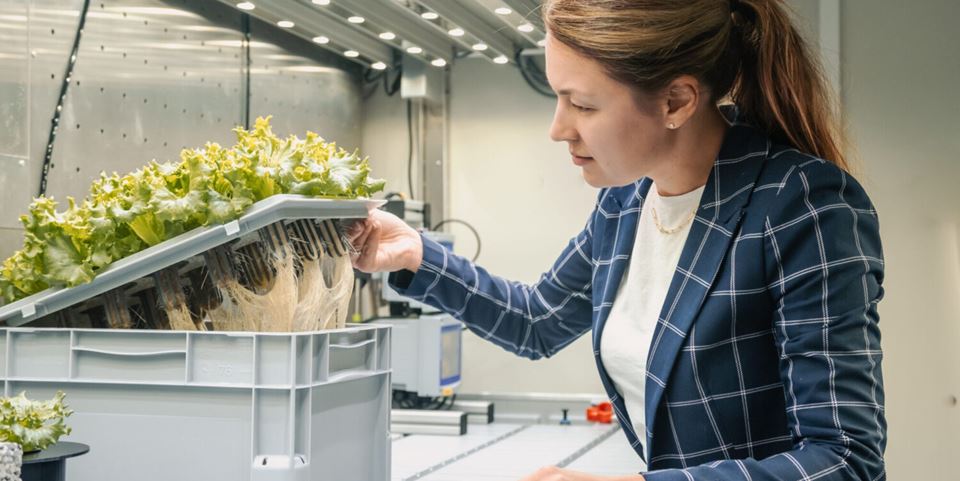Imagine you’re a lunar astronaut, putting in a hard day’s work building your lab or excavating moon rocks. You get back into the hab and ask, “What’s for dinner?” The answer could be “We’re starting with a Moon salad” featuring lettuce and other goodies grown on the lunar surface. It’s an idea scientists are researching as part of a project called LunarPlant, an effort to figure out ways to grow healthy veggies on the Moon.
The obvious idea is to use hydroponics methods for lunar farming. However, there’s no good Earth soil for planets to anchor into, so they’ll need something else. Galina Simonsen, a researcher at the independent European agency SINTEF, is exploring different approaches to hydroponics and aquaculture.

She points out that using lunar regolith is not a great idea because it’s difficult to use for plant growth. And, the “farm environment” has to be indoors since the lunar surface is alternately baked or frozen.
Hydroponics (sometimes called “aquaculture”) needs lots of water. That’s fairly abundant on the Moon, but someone will have to extract, transport, and melt it down for use. “Radar data indicate that the Moon’s polar regions hold more than 600 billion kilograms of ice”, said Simonsen. “This is enough to fill about 240,000 Olympic-sized swimming pools. It is much less than we have on Earth but will be enough to enable humans to maintain some level of activity.”
Moon Salad Substrates Needed
So, that solves the water problem for hydroponics. Anybody who has grown plants in water here on Earth, however, knows that plant roots need anchors. And, those water gardens need fertilizer. “Soil substitutes” such as rockwool solve the first problem. “We’re trying to find out how we can get the plants to grow without collapsing”, said Simonsen. “This involves identifying a growing medium that enables plants to develop a root system that gives them adequate support”, she says.
Here on Earth, folks who use hydroponics depend on the rockwool substitute for dirt. It’s great on Earth, but not a sustainable substitute for lunar farms. “Sending rockwool to the Moon could cost up to NOK 20 million [more than $18 million USD] per kilo”, explained Simonsen. “For this reason, it is important that we can use a material that is entirely circular. It has to be light and multifunctional.”
In other words, lunar farmers need a material recycled from another use. It turns out that the SINTEF team and a group of researchers in Finland have a great substitute. It’s a cellulose-based alternative that comes from plant waste. It looks like compressed hay or straw. And, it would work great as insulation for transporting equipment to the Moon. After unpacking, then the hydroponics farm can use it as a plant substrate for growing vegetables.

Fertilizing Lunar Salad Plants
Okay, so the cellulose packing material solves one problem. But, how do you fertilize Moon plants? There’s not a lot of material on the Moon to make chemical fertilizers often used on Earth farms. Some nutrients might be available in lunar regolith, but not enough to sustain large numbers of farms. So, lunar explorers will turn to a tried-and-true method of providing nutrients for the farm: recycled urine. Mix pee with water and you get “liquid gold” that can keep plants healthy and growing. That makes it pretty valuable as a fertilizer. It can provide nitrogen, potassium, and phosphorous.

However, people don’t usually use urine as a fertilizer for food plants here on Earth. That’s because of the fear of spreading disease. And, there are other problems. “Barriers linked to the use of urine as a fertilizer include the strict regulations governing the use of human waste in food plant cultivation”, said Simonsen. “In addition, the handling of human urine is generally unpleasant, combined with the odor and the fact that it releases long-lived organic environmental toxins and trace metals.”
Those aren’t insurmountable problems, however. If urine recycling helps cultivate salad plants, lunar farmers can also grow other edible plants that can assist with the regulation of both the water quality and nutrient balance in the system, according to Simonsen. Plants grown in a future type of lunar “liquid gold” need to be analyzed carefully, she pointed out. “That’s so that we can identify safe threshold values with a view to approving their use as a food source. Moreover, the plants themselves have to contain sufficient nutrients.”
Applying Moon Salad Lessons Learned to Earth Gardens
The idea of using the cellulose base for plant propagation on the Moon comes from technology used in oil and gas transport here on Earth, according to Simonsen. “The methods we apply for fluid hydrocarbon transport in major installations can be transferred to the mechanisms working in minute structures such as these plant substrates”, she said. “Our aim is to construct a digital model that simulates the different factors that influence the behavior of the substrate”, explained Simonsen. “This will enable us to run simulations under conditions that are identical to those on the Moon, including the effect of weightlessness”, she says.
It turns out that the same technologies, including the reuse of urine-based “liquid gold” will be useful in more arid regions here at home. “This method of cultivation can be applied anywhere,” she said, “and is particularly important in the context of resource utilization. Urine contains phosphorous, which is a non-renewable resource, and rockwool, which is currently used in a number of situations, is not biodegradable.”
Simonsen and others hope to apply these methods to the upcoming Artemis missions to the Moon. That and other trips are the first steps toward long-term exploration and habitation of the lunar surface.
For More Information
Cultivating Salad Plants That Can be Grown on the Moon
Lunar Plant – Hydroponic Plant Cultivation on a Lunar Base Using Nutrient Sources from Human WasteFarming on the Moon

